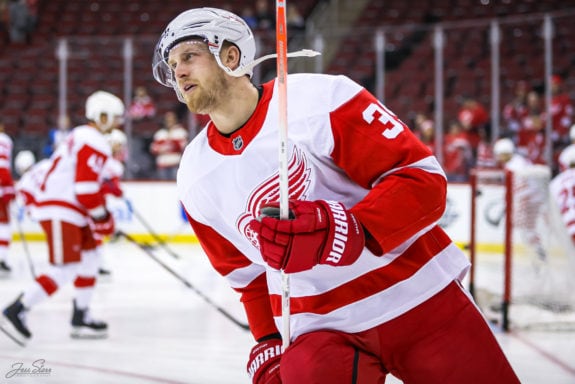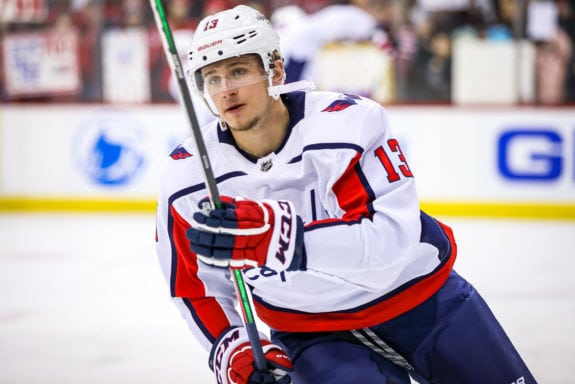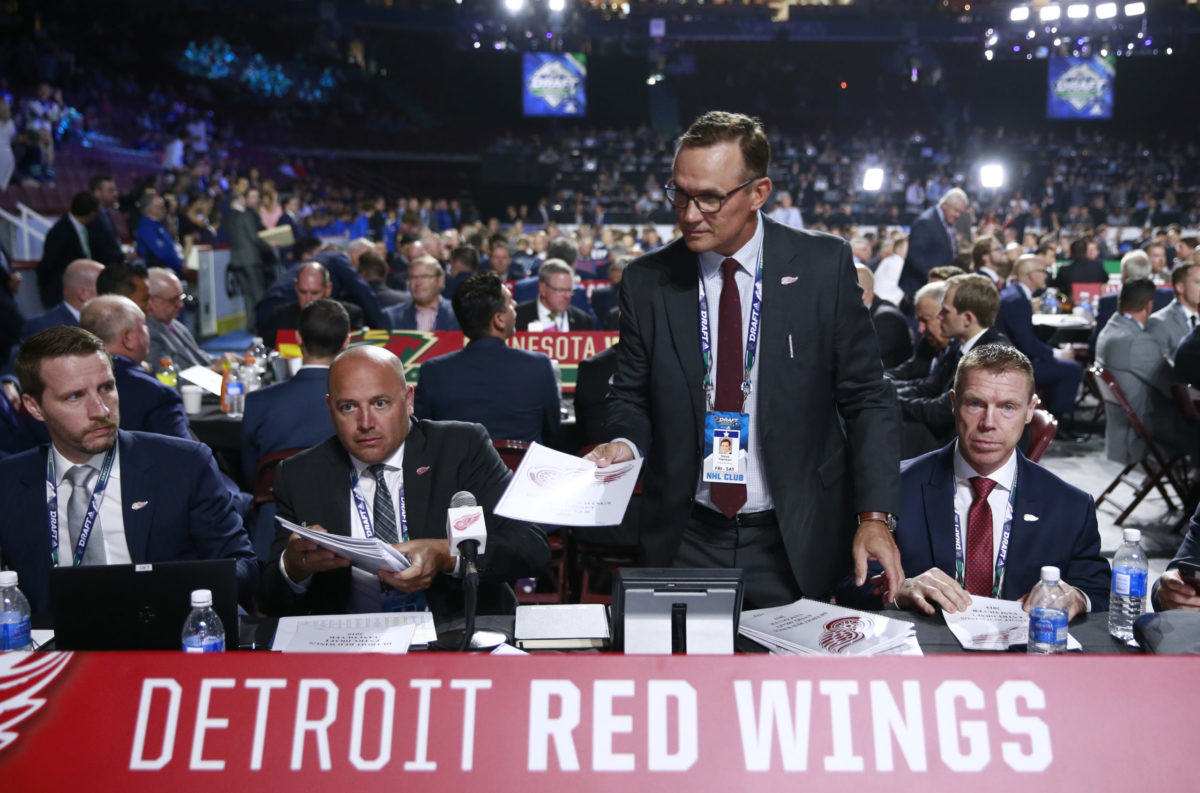Even though all of Hockeytown is still just getting to know Jakub Vrana, he represents one of the biggest items on general manager Steve Yzerman’s to-do list this summer. The young forward acquired in the Anthony Mantha trade finds himself in the exact same spot that Mantha was in last summer as a pending restricted free agent (RFA) that seems destined for a healthy payday once the two sides come to an agreement.
And they will come to an agreement. After all, Yzerman didn’t herald Vrana as an immediate replacement for Mantha for nothing. The 25-year-old forward has seemingly fit in well with his new team; he’s getting more ice-time than he ever did with the Washington Capitals, and he’s scoring at an incredible (though unsustainable) rate through his first month with the Red Wings. The marriage between the team and this player is very much still in the honeymoon phase, and both parties should be eager to reach an agreement. I mean come on – who wouldn’t want to get a deal done after seeing this:
But what will that agreement look like? With a current cap-hit of $3.35 million, the Red Wings must submit a qualifying offer with at least that much value just to retain his rights as an RFA. However, the final number will undoubtedly come in higher than that. In fact, as I’m about to explain, Yzerman should have a clear path forward when it comes to determining the value of Vrana’s next deal.
Mantha Similarities
As my THW colleague Tony Wolak illustrated, Vrana and Mantha’s underlying numbers were eerily similar at the time of the trade. Those numbers, as well as Vrana’s ability to jump right into Mantha’s spot in Detroit’s top six, suggest that Yzerman could approach this situation in a similar manner to how he handled Mantha’s contract negotiation last year. In fact, the similarities aren’t just based in each player’s stats; Mantha’s previous contract carried a cap hit of $3.3 million – just $50,000 shy of Vrana’s current number.

Mantha’s current contract is the first big-time deal that Yzerman negotiated while at the helm of the Red Wings. The four-year pact carries a cap hit of $5.7 million, and does not include a no-movement clause or anything of that sort. At the time the deal was signed, I went as far as to say that the Red Wings were getting the better end of the deal, and I still stand by that assessment even though Mantha now plays in Washington D.C.
Mantha had 173 points in 260 games at the time he signed his current deal. As of this writing, Vrana has 164 points in 292 games. There’s no arguing that the differences between these two players are slim, but does that mean that Detroit should simply give Vrana some variation of the Mantha and call it good?
Other Considerations
While Vrana is coming into this negotiation from a similar place as Mantha from a statistical standpoint, it is undeniable that their situations are far from similar. The Red Wings drafted Mantha, who was very used to life in the state of Michigan by the time he signed his current deal. It’s most likely that Vrana has yet to find a place to live in Michigan, let alone get settled in after spending the last six years within the Capitals organization. Mantha knew first-hand what he was signing on for. Vrana is still figuring that out.
Even though Vrana has been electric since joining the Red Wings, it is incredibly hard to judge a fit between a team and a player based off of less than a dozen games. There’s also something to be said for the realignment of expectations: Vrana was able to lurk in the shadows of players like Alex Ovechkin and Evgeny Kuznetsov in Washington, but there’s nobody like those players in Detroit; he’s now front and center as a key member of the Red Wings’ offense. If he isn’t producing, the Red Wings’ record will undoubtedly suffer because of it. To that point, there’s also something to be said for going from a Stanley Cup contender to a team that’s firmly in a rebuild. It’s not like he hand-picked Detroit and said, “send me there.”

On the Red Wings’ side of things, there are a few factors at play. While I think the ultimate hope is that Vrana plays his way into Detroit’s long-term plans, that is far from a given. Let’s not forget that his inconsistent play this season led to Capitals head coach Peter Laviolette making him a healthy scratch for a couple games, which eventually led to Capitals GM Brian MacLellan finding a new home for the Czech winger. Yzerman hasn’t been keen on throwing big-time contracts at anybody since becoming the Red Wings’ GM, let alone players that may or may not have a commitment issue.
Furthermore, even though Yzerman admitted that the Red Wings’ wealth of cap space isn’t exactly “by design”, I’m sure that it is his intention to maintain that flexibility for as long as he can. This is where he has to walk a fine line with Vrana’s next deal: signing him to a short-term deal should keep the overall cap hit down, and it affords the Red Wings some options in the short-term, but it risks having to sign him to a BIG-boy contract as an unrestricted free agent (UFA) should the fit between player and team ultimately work out.
On the other hand, signing him to a deal with term on it – probably in the same ballpark as Mantha’s deal – should lock him down at an affordable price today that could look better and better as time goes on. However, with so much unfamiliarity between the two parties, it remains to be seen whether or not both parties would be willing to go long-term with each other.
Final Number
As I said in the beginning of this article, the two sides will undoubtedly come to an agreement. In terms of term, the deal will most-likely fall somewhere in the two-to-four year range, buying up anywhere from one to three years of Vrana’s UFA eligibility. Giving him some term not only helps Detroit lock down an important piece of their offense, but it would also give some structure to the Red Wings’ otherwise pretty blank cap picture. Furthermore, as evidenced by the deal that brought him to Detroit, as well as another deal the Red Wings completed, teams are willing to pay premium assets to acquire top-six forwards with term on their deal.

As for dollar value, I do think the deal will closely mirror the deal Yzerman gave Mantha, though the exact terms might differ a little. I’ll offer up these two guesses for Vrana’s next deal: either a two-year deal at a $5 million cap-hit, or a three-year deal at $5.5 million. With plenty of cap space available, the Red Wings can afford to throw some serious money at him if they wish, but given his RFA status, they should be able to save a little bit, just as they did with Mantha’s deal.
All things considered, this negotiation could be the most fascinating one to watch as far as the Red Wings are concerned. The outcome could paint a clear picture of how both parties feel about each other, and very well might tell you whether or not it’s a good idea to invest in a new No. 15 jersey. Regardless of the outcome, Red Wings fans should be excited. A deal is going to get done, and that means Hockeytown can expect to enjoy even more highlights from a player who has already added a needed spark to a bland Red Wings offense.
Want more Red Wings content? Tune into The Hockey Writers’ Grind Line — a weekly show on YouTube and Facebook. We stream weekly on The Hockey Writers YouTube channel. Check out our most recent show below, and make sure you subscribe to the channel so you don’t miss any upcoming shows.